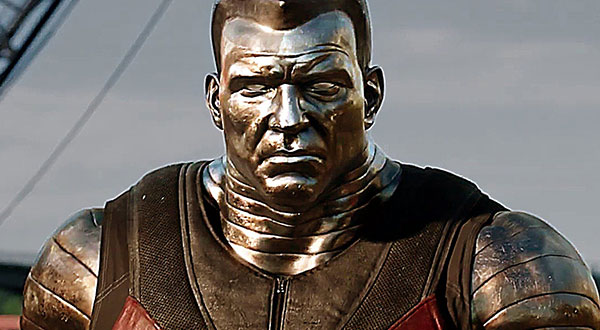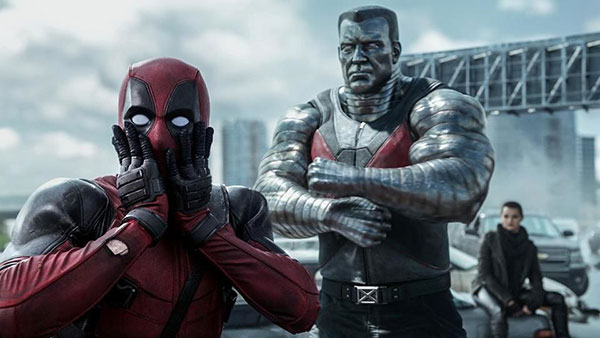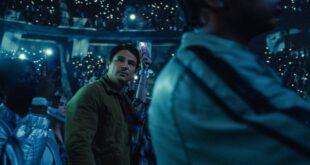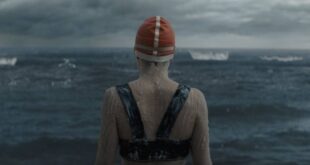Bringing the character of Colossus to life in the film “Deadpool” was certainly no easy task, as he is more than just another CG or plain ol’ motion capture performance. Bringing Colossus to life in the film was a very special combination of these elements and “Deadpool” is one of the very first films to use facial motion capture technology on a major character. You can check out the special VFX featurettes about what it took to bring Colossus to life here!
“Deadpool” director Tim Miller called upon facial motion capture artist Greg LaSalle to lend his expertise and acting ability to assist with bringing this incredible character to life. We recently had a chance to catch up with Greg LaSalle to gain some insight into this new technology, as well as, learn what he enjoyed the most about his time spent with the Colossus character and which elements of the character gave him the biggest challenge.
When asked what it was like to be a part of the whirlwind that is surrounding “Deadpool”, LaSalle tells us, “It’s hard to put it in perspective because I keep myself separated by doing the same things I do during the day, I just see a lot of billboards now. (laughs) I think for me it’s a blast because I’ve known Tim Miller for so long and we’ve worked together on projects in the past. To me it’s the project that should have organically and did happen and I look at it more for the perspective of working with people I really like to work with than the final product. To see the film and say ‘This is so much fun’, and it is so wrong, but if you know the people involved with the film that’s like dinner conversation for them! (laughs)
It’s pretty much like second nature to have those things come out, it just the icing on the cake and it has been a blast. It’s so funny and it’s good! I love the love story, I love the action and I love the comedy of it and I’m super lucky on my part, that’s the way I look at it!”
He jokingly adds, “I can’t decide if my favorite part of the film is the opening credits”, as “Deadpool” hits the ground running right away. He continues, “That’s my favorite credits that I’ve seen in my entire life and I don’t think anything will top it unless Tim does “Deadpool 2” and somehow manages to do even more”.
When discussing the decision to keep the character of Colossus in his metal form in “Deadpool”, LaSalle says, “I don’t know why the decision was made to do it one way or another. For storytelling purposes it never really needed to not be in chrome I suppose, maybe at the very beginning, but I’m not 100% sure why, but I’m glad because I think it actually it is better to have him be consistent throughout the whole film.”
LaSalle also went on to explain a bit about the process behind facial acting and the ways in which it is different than voice acting. He tells us, “We are now starting to use the term Facial AVR, which is either the actor’s original voice is there or in this case he is played by someone who could actually speak Russian. To flip it from voice acting where you are just watching the picture or looping at the end of a film where the audio is not pristine enough at the end of a film so they go back a re-record the dialogue, so this would be the opposite.
What I would do is just practice for days before filming to get the timing down so I didn’t have to think about that anymore because when you are performing you definitely don’t want to be in your head thinking about timing and where things start and end. You need to be concentrating on what you are doing and your behavior and the point you are trying to get across. I just rehearsed for days before hand with WAV files, so I just knew the timing of the audio and then when I worked with Tim that’s when we brought in aspects of Colossus’s attitude, behavior and responses. The actual process is just me sitting in front of, in this case, an array of 29 cameras and watching the clip a few times to get a sense of what’s going on and then shutting that off, so I’m just facing the cameras giving a performance, but I can hear the audio.
The reason for the 29 cameras is so that they can reconstruct the actor’s face for every frame of film and then mathematically transfer that performance onto the computer generated character. Unlike traditional motion capture which is a little bit different, this one actually drives the computer generated character from the performance directly, there’s very little animator intervention, especially since Colossus really didn’t have eyes.”
The process definitely carried over fantastically in the film, and certainly brought about almost a sense of realism to the character of Colossus. LaSalle comments “ That was the whole reason behind developing this particular process, so that all the subtly of the actor’s performance goes through. With the previous technology, so of that’s there, but it’s not as neat in the subtly of the performance, there’s no variation. With this new technology all the variation in every single frame is there.
We really thought about it at the end, where Colossus makes his speech and you have to believe that he means what he says. Just animating his lips wouldn’t really get that across because you need to believe that he believes it and that comes through in the performance I think.”
We told LaSalle that it was indeed like watching a real person rather than an animated character in the film and he jokingly commented “Especially the throwing up at the end!” When asked if that scene in particular was at all challenging, he goes on to tell us “That was the hardest thing I’ve ever done. It is physically challenging because you have to get yourself to vomit without having any projectile media. It got to the point where I was almost passing out and we had to stop and catch a breath and then start over again. By that point you are just exhausted because when you’re sick, you’re whole body is in it. You don’t just fake it to move your face like you’re vomiting. “
When speaking about the challenges of pretty much being alone with only the 29 cameras and the audio track to play off of LaSalle reveals “I think most actors would prefer to have someone else to play off of because modifications in the performance mean you’re going to get a different response. I mean, I’m not playing off of Tim, but Tim is giving me feedback after each take, so there is sort of a response there and that is very helpful. But I think it is better to play in front of other people. For these characters it’s also fun to do it this way because you can do whatever you want. You can go to the wall with it, you have a lot of room for experimentation where you don’t have to worry about using up someone else’s time or anything.”
When talking about what he took away from his time spent at the character of Colossus, LaSalle comments, “One of the reasons I like this character so much is that because deep down inside he’s not that dissimilar from me. I think that’s one of the reasons Tim gave me the part was playing that sincerity and the frustration of his character. Tim originally explained like he was the straight character to Ryan, and he is as he is certainly the butt of some jokes, but I think everyone in the movie is the butt of some jokes. No one is safe from Deadpool’s snarky wit! The character is really empathic towards trying to be good and do the right thing and really trying to convince Deadpool to do that in a sincere way. I think that what made it so interesting, I don’t come out there as a big strong guy beating people up whenever it looks like someone is in trouble. “
LaSalle explains to us a bit about the differences between being a Facial Motion Capture supervisor versus actually being the actor saying “I actually love acting more than anything else, so for me it’s a blast. It’s a lot of hard work to get to the point where you’re actually filming, but I love that challenge. To me it’s much for fun to be learning and trying new things all the time. But on the flip-side, being the supervisor I get to work very closely with some incredible actors over the last 10 years, as well as, fantastic directors, so I feel that’s a little bit of an education that there is no way I would ever be able to buy. I have been studying acting as well, but I think having both of those things is a really unique experience.”
As for what is next on the horizon, LaSalle reveals “I just finished filming, with Ryan’s wife actually, Blake Lively, called “All I See Is You”. I don’t know if there is a release date yet for it, but that’s the next thing that I have coming up.”
We also recently caught up with actor Stefan Kapicic to discuss his part in bringing Colossus to life, you can read the interview here!
 Age of The Nerd
Age of The Nerd





